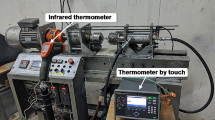Abstract
Specimens of UNS S 31600 stainless steel with precast crack were treated under different discharge parameters. An elliptic hole formed ahead of the crack tip and the thermal compressive stress caused during electropulsing treatment cause the crack arresting. The factors affecting the curvature radius of the crack tip were studied. The crack arrest effect was examined by tensile test and fatigue test. Scanning electron microscopy (SEM), electro backscatter diffraction (EBSD), and transmission electron microscope (TEM) were employed to examine the changes of specimen before and after the treatment. The local recrystallization occurred around the crack tip. The experimental results indicate that the curvature radius of the crack tip is proportional to discharge parameter and crack length. The relationship between discharge parameter and the effectiveness of crack arrest can be obtained.
Similar content being viewed by others
References
Sharma S (2012) Wear study of Ni-WC composite coating modified with CeO2. Int J Adv Manuf Technol 61:889–900
Sasikumar P, Kannan G, Haq AN (2010) A multi-echelon reverse logistics network design for product recoveryCa case of truck tire remanufacturing. Int J Adv Manuf Technol 49:1223–1234
Pi G, Zhang A, Zhu G, Li G, Lu B (2011) Research on the forming process of three-dimensional metal parts fabricated by laser direct metal forming. Int J Adv Manuf Technol 57:841–847
Ren D, Liu L, Li Y (2012) Investigation on overlap joining of AZ61 Magnesium alloy: laser welding, adhesive bonding, and laser weld bonding. Int J Adv Manuf Technol 61:195–204
He BY, Soady KA, Mellor BG, Morris A, Reed PAS (2013) Effects of shot peening on short crack growth rate and resulting low cycle fatigue behavior in low pressure turbine blade material. Mater Sci Technol 29(7):788–796
Song PS, Shieh YL (2004) Stop drilling procedure for fatigue life improvement. Int J Fatigue 26:1333–1339
Sosnis OV, Gromova AV, Suchkova EYu., Kozlov EV, Inanov Yu F, Gromov VE (2005) The structural-phase state changes under the pulse current influence on the fatigue loaded steel. Int J Fatigue 27:1221–1226
Li, XB Lu, FG Cui HC, Tang XH (2013) Effect of electric current pulse on flow behavior of Al melt in parallel electrode process. Mater Sci Technol 29(2):226–233
Zhou YZ, Guo JD, Gao M (2004) Crack healing in a steel by using electropulsing technique. Mater Lett 58:1732–1736
Fu YM, Zhou HM, Wang JL, Zheng LJ (2012) Analysis of crack arrest by electromagnetic heating in metal with oblique-elliptical embedding crack. Key Eng Mater 525-526:404–408
Fu YM, Chai X, Zheng LJ, Li H (2011) Pulse discharge strengthening of 16Mn welded joint and mechanical performance. Adv Mater Res 197–198:1460–1463
Wang P, Bai XZ (2011) Phase transformation stress and its influence for arresting crack propagation using electro-heating effect. China Mech Eng 22(8):980–984. in Chinese
Lin HQ, Zhao YG, Ma J, Jiang QC (2008) Effects of pulse electric current simulation on the microstructure, mechanical properties and thermal fatigue behavior of cast-hot-working die steel. ISIJ Int 48:212–217
Lin HQ, Zhao YG, Gao ZM, Han LG (2008) Effects of pulse current simulation on the thermal fatigue crack propagation behavior of CHWD steel. Mater Sci Eng A 478:93–100
Lin HQ, Zhao YG, Ma J, Jiang QC (2008) Formation and thermal fatigue properties of fine-grained heat affected zone on cast-hot-working-die steel after electropulsing simulation with high current density. ISIJ Int 48:1652–1658
Satapathy S, Stefani F, Saenz A (2005) Crack tip behavior under pulsed electromagnetic loading 2004 12th IEEE Symposium on Electromagnetic Launch Technology, Snowbird. UT, USA, pp 106–110
Liu TJC (2008) Thermo-electro-structural coupled analyses of crack arrest by Joule heating. Theo Appl Fract Mech 49:171–184
Liu TJC (2011) Finite element modeling of melting crack tip under thermo-electric Joule Heating. Eng Fract Mech 78:666–684
Yu J, Zhang HC, Deng DW, Iqbal A, Hao SZ (2013) Simulation and experiment for crack arrest in remanufacturing. Int J Adv Manuf Technol. doi:10.1007//s00170-013-5293-2
Hasebe N, Bucher C, Heuer R (2009) Analysis of thermal conduction and stress induced by elelctric current in an infinite thin plate with an elliptical hole. J Therm Stresses 32:1065–1086
Hasebe N, Bucher C, Heuer R (2010) Heat conduction and thermal stress induced by an electric current in an infinite thin plate containing an elliptical hole with an edge crack. Int J Solids Struct 47:138–147
Fu Yuming, Bai X, Zheng L, Xu H (2002) Relationship of crack arresting effects by electro-magnetic heat effect with crack direction. Chin J Appl Mechs 19 (2):117–120. in Chinese
Yuming BX, Hongming X (2002) Research on relationship of crack arresting effect using electromagnetic heat effect with dimension of current path. J Mech Strength 24(4):558–561. in Chinese
Qin RS, Su SX, Guo JD, He GH, Zhou BL (1996) A healing model for metallic materials: theoretical study. Biomimetics 4:121–128
Du XN, Wang BQ, Guo JD (2007) Formation of nanocrystalline surface of a Cu-Zn alloy under electropulsing surface treatment. J Mater Res 22(7):1947–1953
Masataka TS(Japan), Li AZ(Transl) (1986) Stress Concentation. Reading, Beijing. in Chinese
Sosnin OV, Gromova AV, Yu FI, Konovalov SV, Gromov VE, Kozlov EV (2005) Control of austenite steel fatigue strength. Int J Fatigue 27:1186–1191
Yizhou ZHOU, Rongshan QIN, Suhong XIAO (2000) Reversing effect of electropulsing on damage of 1045 steel. J Mater Res 15(4):1056–1061
Song H, Wang Z (2008) Microcrack healing and local recrytallization in pre-deformed sheet by high density electropulsing. Mater Sci Eng A 49:1–6
Kadiri HEI, Oppedal AL (2010) A crystal plasticity theory for latent hardening by glide twinning through dislocation transmutation and twin accommodation effects. J MECH PHYS SOLIDS 58(4):613–624
Junshi W (1993) Influence of austenitic grain size of P50 railway steel on threshold value and crack growth rate. Mater Mech Eng 17(5):9–10. in Chinese
Author information
Authors and Affiliations
Corresponding author
Rights and permissions
About this article
Cite this article
Yu, J., Zhang, H., Deng, D. et al. Analysis of the relationship of crack arrest effects with fusion zone size by current detour and Joule heating. Int J Adv Manuf Technol 87, 1465–1474 (2016). https://doi.org/10.1007/s00170-014-5949-6
Received:
Accepted:
Published:
Issue Date:
DOI: https://doi.org/10.1007/s00170-014-5949-6




